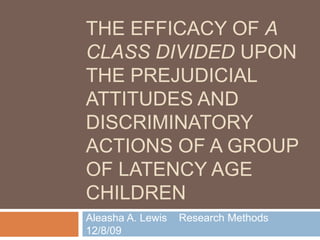
A Class Divided
- 1. The Efficacy of A Class Divided Upon the Prejudicial Attitudes and discriminatory Actions of a Group of Latency Age Children Aleasha A. Lewis Research Methods 12/8/09
- 2. Jane Elliott’s Daring Exercise Why Did They Kill a King? Jane needed to create an intrinsic understanding within the students in her all-White 1968 Riceville, Iowa classroom, following the brutal assassination of Dr. Martin Luther King, Jr., the night before at the Lorraine Motel in Memphis, Tennessee.
- 3. Jane divided her class into two groups, those with blue eyes and those with brown eyes. The first day of the exercise, the group with blue eyes was the group with power and privilege and the brown eyed students were treated unfairly, unjustly and oppressively. The next day the exercise was reversed. The results were remarkable. The third time she performed the exercise, it was chronicled for PBS’ Frontline television series in A Class Divided. Blue Eyes Brown Eyes Exercise
- 4. Ethics of Prejudice & Discrimination Reduction Exercises Byrnes & Kiger (1992) Coercion Invasion of Privacy Informed Consent Stress
- 5. Beyond Race Toward Gender Applicability: Gender Bias Volk & Beeman (1998) Despite conducting an exercise toward understanding and eliminating prejudice and discrimination, some noted that Ms. Elliott paid more attention to the boys than the girls in A Class Divided. Possible reasons: true bias; just responding in kind; male students requiring more redirection/control; outcome of editing process
- 6. Simulation Exercise: Multi-faceted Approach Salzman & D’Andrea (2001) 10 guidance activities designed to reduce prejudice by children One activity called “Labeling” mimicked Elliott’s exercise, by dividing boys and girls, labeling boys as “bad” Student reactions were then related to plight of others Multi-faceted approach effective
- 7. Another Multi-Faceted Approach to Tolerance Lewis (1995) 32-week comprehensive multicultural awareness program for troubled youth No need for prejudice “simulation” – children already behaved with prejudice and discrimination Fights and infractions were greatly reduced Multi-faceted approach very effective
- 8. Wider Applicability: Lesson in Labor & Economic Discrimination Fryer, et al. (2005) Computer simulation game involving employees and employees (university-age students) Modified Blue Eyes Brown Eyes Exercise, using green workers and purple workers Workers who were discriminated against based upon green or purple color became discouraged and did not invest as much; workers who were guaranteed a job due to color defended their entitlement; and still others took a “free ride”
- 9. Television as Effective Means of Inducing Behavioral Change? Persson & Musher-Eizenman (2003) Well-known that TV teaches facts Television shows depicting diverse characters and/or conveying anti-prejudice and anti-discrimination messages were shown repeatedly over time to young children Children came to understand more about characters and plot, but preferences for in-group stimuli did not change
- 10. Overall, researchers seem to agree that prejudice- and discrimination reduction simulation exercises are effective and justifiable, if conducted expertly, ethically and with the least harm. Today’s multicultural classroom must be taken into account.
- 12. measure responses (pre-and post-Likert questionnaire; anecdotal evidence; debriefing of participants and host/collaborator)
- 13. analyze data relative to related prejudice/discrimination reduction